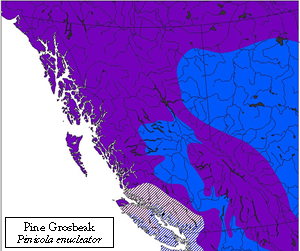Adult male
Back and scapulars grey with irregular blackish or dark grey streaking or scalloping and often a variable pinkish-red to dark red suffusion (especially in coastal and northeastern populations). Wings blackish-grey with two bold white wing bars and extensive white fringes on the flight feathers (primaries, secondaries, tertials). The rump and uppertail coverts are relatively bright red with blackish feather centres on the uppertail coverts. The notched tail is relatively long and slender and is wholly dark blackish-grey (darker above). The underparts are pale grayish (palest on the undertail coverts) with variable pinkish-red to deeper red on the breast, upper belly, and flanks (usually retaining a grey area up the sides to the sides of the breast); the reddish colouration on the underparts of P.e.montanus is largely restricted to the breast and is not as extensive as in other subspecies. The head is pinkish-red to deeper red throughout, with a grayish-white chin and crescent below the eye, a thin blackish or dark grey line through the eye, and blackish nasal tufts. The iris is dark and the legs and feet are dark grey. The conical bill is short and stubby and has a distinctly curved culmen; it is dark grey to blackish with a paler, horn-coloured base to the lower mandible.
Adult female
The upperparts are grayish with inconspicuous darker grey streaking and scalloping on the back and scapulars. The wings are dark grey with two bold white wing bars and narrow white edges to the flight feathers. The rump and uppertail coverts golden-yellow to greenish-yellow. Tail similar to adult male. Underparts wholly greyish, sometimes with a golden-yellow or greenish-yellow wash on the breast. The crown, nape, and sides of the face are golden-yellow to greenish-yellow, contrasting with the grayish sides of the neck and malar area and whitish-grey chin and throat. The lores and crescent under the eye are whitish-grey and there is a relatively short dark grey line through the eye and narrow, inconspicuous whitish line above the eye. The nasal tufts are blackish. Bare part colouration is as in the adult male.
First-winter immature
This plumage is acquired in the late summer or early fall of the first year and is retained until the following fall. First-winter immatures of both sexes are very similar to the adult female, and first-winter females may be indistinguishable from adult females based on plumage patterns. First-winter males are extremely similar to females, but the head and rump are golden-orange or reddish-bronze rather than yellowish-green. Both sexes tend to show a buffier or brownish-tinged throat in immature plumage that can help differentiate them from adult females.
Juvenile
This plumage is held only briefly, during the summer (June-September) of the first year. Juveniles are overall brownish or buffy, with no scalloping or streaking. The two wing bars and edges of the wing feathers are buffy.
Measurements
Total Length: 23-24 cm
Mass: 54-56 g
Source: Adkisson (1999); Sibley (2000)
Pinicola enucleator (Linnaeus, 1758)
Pine Grosbeak
Family: Fringillidae
Species account author: Jamie Fenneman
Pine Grosbeak
Family: Fringillidae
Species account author: Jamie Fenneman
Species Information
Biology
|
Habitat
|
Distribution
|
Conservation
|
Taxonomy
|
Status Information
BC Ministry of Environment: BC Species and Ecosystems Explorer--the authoritative source for conservation information in British Columbia. |

